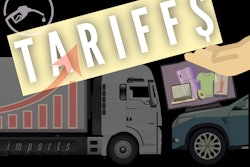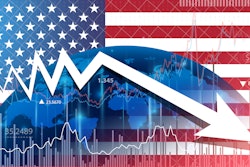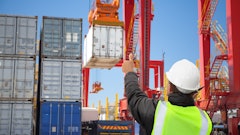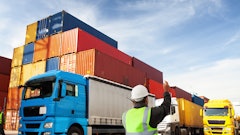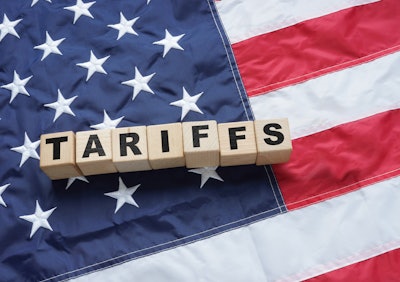
The latest hike to 50% tariffs on all steel and aluminum imports will do one thing: make almost everything more expensive. That means higher costs for businesses, higher prices for consumers, and inflationary pressure that risks slowing the economy and raising borrowing costs.
Let’s be clear: tariffs are taxes. U.S. consumers and businesses pay them. And while steel and aluminum aren’t things people buy directly, they’re essential inputs in the things we do buy, like appliances, cars, electronics, packaging, construction materials, and more. There are two main ways tariffs on steel and aluminum appear in consumer goods: as core inputs to the product itself, such as steel in an oven or aluminum in a laptop body, and as packaging, like steel cans for vegetables or aluminum for soda and beer.
It’s a straightforward dynamic. When input costs go up, so do product prices. The price hike isn’t immediate because businesses will first burn through pre-tariff inventory that they stockpiled to shield customers and buy time. But once that inventory runs out, companies will be forced to pay tariff-inflated rates, and those costs will be passed on to consumers.
And these aren’t small increases. For many categories, the impact is significant. To put it in context, the Fed gets nervous when inflation hits 3–4%. This latest round of tariffs just doubled the tax on steel and aluminum to 50%.
How bad could it get?
Say you’re a U.S. manufacturer making products that are mostly steel or aluminum, like metal framing or beverage cans. Your cost of goods sold (COGS) went up by 20% as of June 4. If steel or aluminum accounts for half of your COGS, such as in home appliances or laptops with aluminum enclosures, your costs increase by about 10%.
A 20% hike is roughly eight times the current U.S. inflation rate. And that’s for goods manufactured domestically. If you're importing finished goods, with multiple stacking tariffs at play, the increase is even more significant.
Some manufacturers are trying to reduce exposure by revising product designs and replacing metal with alternative materials where possible.
Packaging is a common target. Expect your favorite holiday tin of cookies to arrive in cardboard or shrink wrap this year. Not as elegant, but cheaper and potentially the difference between a consumer buying or passing. Pepsi has already flagged that higher aluminum costs may lead to greater use of plastic packaging. They already bottle in plastic, so manufacturing disruption is minimal. But downstream retailers with shelving built for cans will now incur switching costs.
Still, for many products, steel and aluminum are non-negotiable. If you manufacture front-loader buckets or car frames, there’s no plastic or wood workaround.
In most tariff environments, companies will seek to shift their sourcing away from countries with higher tariffs toward those with more favorable terms. But in this case, the 50% tariff applies to all countries. Swapping a Chinese supplier for a Canadian one offers no relief.
The only remaining move would be sourcing more steel and aluminum domestically. It sounds great in theory. After all, tariffs give U.S. producers a pricing edge. But in practice, they simply can’t meet demand.
Can domestic supply scale?
Currently, approximately 25% of U.S. steel and 50% of U.S. aluminum are imported from overseas. Nearly all of that aluminum comes from Canada. That’s a big supply gap to fill.
Companies could build more U.S. steel and aluminum plants, but only if they’re willing to play the long game. It’s a big hurdle because these industries are capital-intensive and slow-moving. They require new grid infrastructure and a massive amount of power, which is something that’s already under pressure from competing AI and crypto industries.
Even if businesses break ground tomorrow, new capacity will take years – if not a decade – to come online. The near-term gap is unavoidable. And if history tells us anything, long-term gains aren’t guaranteed.
However, the biggest risk by far to investment in domestic steel and aluminum production is policy uncertainty, in that the tariffs imposed today could be gone tomorrow. That’s not a conducive environment for long-term billion-dollar investments.
The competitive risk
When the Trump administration imposed 25% tariffs on steel and 10% tariffs on aluminum in 2018, the assumption was that domestic output would increase. Instead, U.S. production of both fell, down 15% for steel and 10% for aluminum.
And because these are fungible commodities, a 50% tax on imports means the price of domestic steel and aluminum will rise, too. History shows that domestic producers adjust prices to just below the new import cost. That’s how commodities work. So even if you’re buying American, you’re still paying more.
The downstream effect is that US manufacturers of products with steel or aluminum inputs become less competitive than foreign competitors. To compensate, industry lobbyists will push for carve-outs and targeted protections. A perfect example is the administration's announcement of a 50% tariff on the steel content of imported home appliances, which took effect on June 23, 2025. In an almost paradoxical circular way, this tariff protects domestic manufacturers disadvantaged by the earlier doubling of steel tariffs.
Of course, this new tariff only applies to the metal components, not the entire product. However, if you're planning a kitchen renovation, such as installing that new fridge, washer, or stove, your costs just went up.
It’s yet another reminder that tariffs are taxes. They don’t disappear. And with across-the-board levies on core inputs like steel and aluminum, there’s no easy way around the pain.
So, what can businesses do?
There are three steps companies should be taking right now to protect themselves:
- Get visibility — If you’re still managing sourcing and trade exposure in spreadsheets, it’s time to modernize. Invest in real-time tools to know what’s happening in the constantly shifting tariff landscape, which is the most fluid trade environment in 80 years.
- Connect trade data back to supply chain — Real-time tariff visibility is an important first step, but it isn’t enough. Better decisions come from knowing what to do with changing tariff information, like how to adjust sourcing, inventory, and planning as policy changes continue to unfold.
- Quickly take action — Whether it’s stockpiling when tariffs get delayed or shifting sourcing in response to a favorable ruling, it’s important to move fast before the policy shifts again. The companies that do will come out ahead.
Bottom line: Be nimble
Uncertainty is the reality for the world going forward for the foreseeable future. This latest escalation of steel and aluminum tariffs to 50%, and the July 9 announcement, also sends a larger message: the U.S. trade posture is no longer predictable, even for close allies. With abrupt policy shifts happening without warning, businesses are learning to treat geopolitical risk as a core factor in supply chain planning and operations.
Unfortunately, in this climate, there are no good answers, just less bad ones. Everyone is getting hurt. While there is no escaping this reality, take steps to move fast and be less hurt than your competition, and in doing so, gain a relative competitive advantage.





